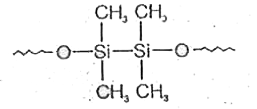Hydrolysis of dimethyldichloro silane , (CH3)2SiCl2 followed by condensation polymerisation yields straight chain polymer of




The correct Answer is:C
To solve the question regarding the hydrolysis of dimethyldichlorosilane, (CH3)2SiCl2, followed by condensation polymerization, we can follow these steps:
Step 1: Understand the Structure of Dimethyldichlorosilane
Dimethyldichlorosilane has the formula (CH3)2SiCl2. This means that the silicon (Si) atom is bonded to two methyl groups (CH3) and two chlorine (Cl) atoms.
Hint: Draw the molecular structure to visualize the bonding.
Step 2: Hydrolysis of Dimethyldichlorosilane
When dimethyldichlorosilane undergoes hydrolysis, the chlorine atoms are replaced by hydroxyl (OH) groups. The reaction can be represented as follows:
\(
(CH3)2SiCl2 + 2H2O \rightarrow (CH3)2Si(OH)2 + 2HCl
\)
In this reaction, the two chlorine atoms are replaced by two hydroxyl groups, resulting in the formation of dimethylsilandiol, (CH3)2Si(OH)2.
Hint: Remember that hydrolysis involves the reaction of a compound with water, leading to the substitution of functional groups.
Step 3: Condensation Polymerization
The next step is condensation polymerization. In this process, the hydroxyl groups from the dimethylsilandiol can react with other dimethylsilandiol molecules. During this reaction, water (H2O) is eliminated, and a siloxane (Si-O-Si) bond is formed.
The general reaction for the polymerization can be represented as:
\(
n \cdot (CH3)2Si(OH)2 \rightarrow (Si(CH3)2O)_n + nH2O
\)
Here, n represents the number of repeating units in the polymer.
Hint: In condensation reactions, always consider the byproducts like water that are formed.
Step 4: Identify the Resulting Polymer
The resulting polymer from this condensation reaction will be a straight-chain polymer consisting of alternating silicon and oxygen atoms, with methyl groups attached to the silicon atoms. The structure can be represented as:
\(
\text{(-Si(CH3)2-O-)}_n
\)
This indicates that the polymer is a siloxane polymer with a straight-chain structure.
Hint: Visualize the repeating unit to understand the overall structure of the polymer.
Conclusion
The straight-chain polymer formed from the hydrolysis of dimethyldichlorosilane followed by condensation polymerization is a siloxane polymer with the general structure of (−Si(CH3)2−O−)n.
Final Answer: The straight-chain polymer is (−Si(CH3)2−O−)n.
Dimethyldichlorosilane has the formula (CH3)2SiCl2. This means that the silicon (Si) atom is bonded to two methyl groups (CH3) and two chlorine (Cl) atoms.
When dimethyldichlorosilane undergoes hydrolysis, the chlorine atoms are replaced by hydroxyl (OH) groups. The reaction can be represented as follows:
(CH3)2SiCl2 + 2H2O \rightarrow (CH3)2Si(OH)2 + 2HCl
\)
The next step is condensation polymerization. In this process, the hydroxyl groups from the dimethylsilandiol can react with other dimethylsilandiol molecules. During this reaction, water (H2O) is eliminated, and a siloxane (Si-O-Si) bond is formed.
n \cdot (CH3)2Si(OH)2 \rightarrow (Si(CH3)2O)_n + nH2O
\)
The resulting polymer from this condensation reaction will be a straight-chain polymer consisting of alternating silicon and oxygen atoms, with methyl groups attached to the silicon atoms. The structure can be represented as:
\text{(-Si(CH3)2-O-)}_n
\)
The straight-chain polymer formed from the hydrolysis of dimethyldichlorosilane followed by condensation polymerization is a siloxane polymer with the general structure of (−Si(CH3)2−O−)n.
Similar Questions
Straight chain polymer is formed by hydrolysis of [x] which is tetrasubstituted chloromethylsilane then followed by condensation polymerization. Atomicity of [x] is:
View SolutionAlkyl substituted chlorosilane, RnSiCl(4−n), on hydrolysis and then condensation polymerisation yield silicones What is the value of n is the alkyl substituted chlorosilane used for the preparation of cross linked silicone.
View Solution
Knowledge Check
Which of the following polymers is prepared by condensation polymerisation?
AStyreneBNylon-66CTeflonDRubber
Which one of the following polymers in not obtained by condensation polymerisation ?
View SolutionThe hydrolysis of trialkylchlorosilane , R3SiCl, yields ……………………..,
View SolutionHydrolysis of Ba3N2 will yield
View SolutionHydrolysis of Ca3N2 will yield
View SolutionBe2C on hydrolysis yields
View SolutionOn controlled hydrolysis and condensation, R3SiCl yields
View Solution(CH3)2SiCl2 underboes hydrolysis but (CH3)2CCl2 does not why?
View Solution